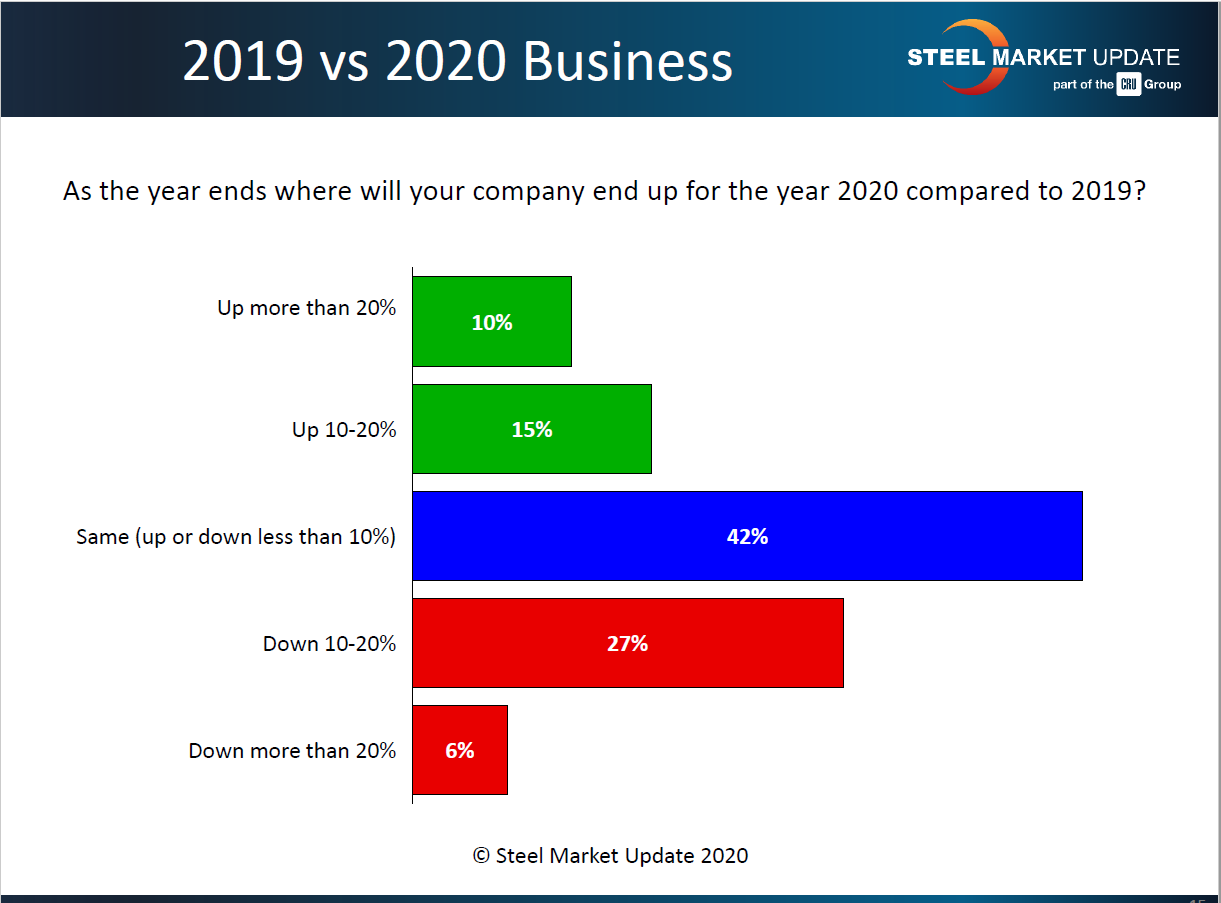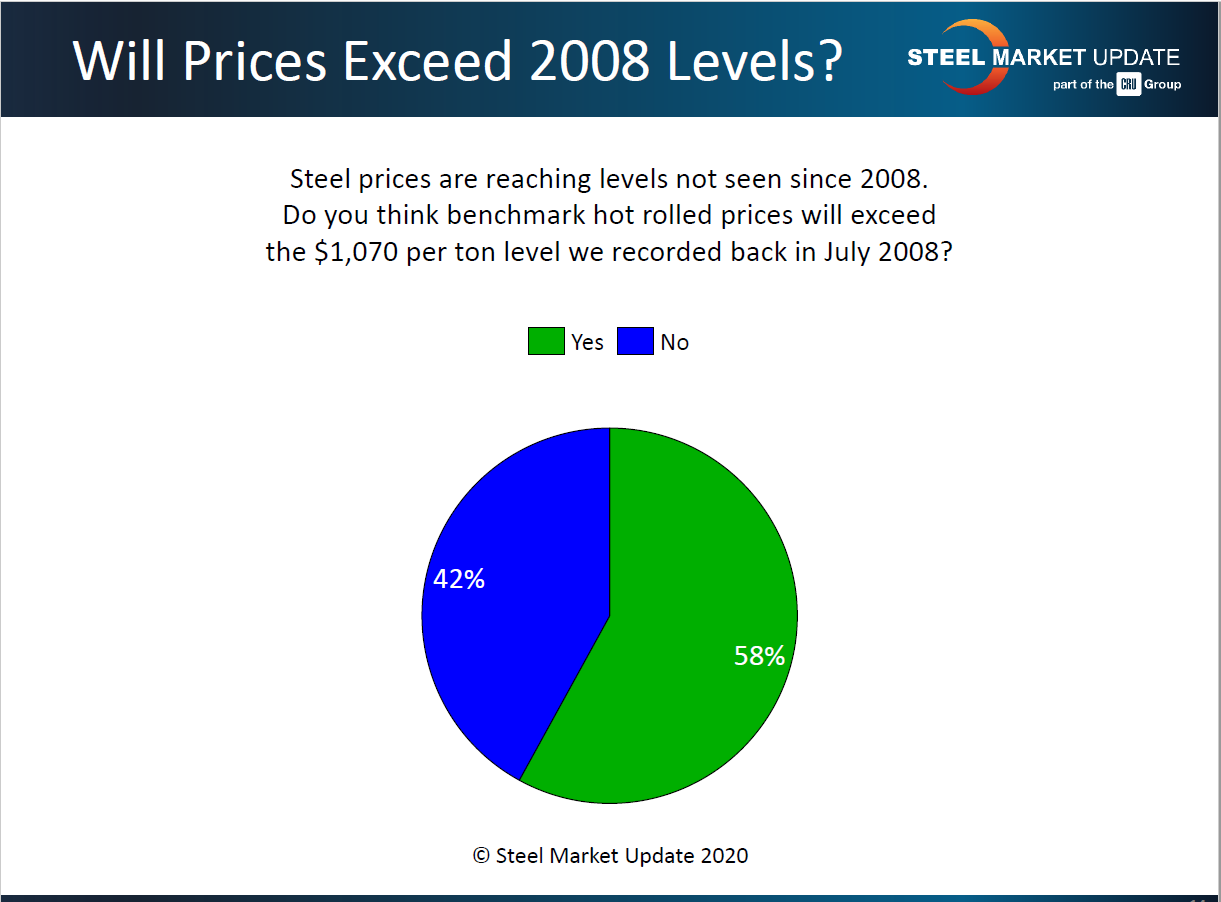SMU Data and Models

SMU Market Trends: Buyers Finish 2020 in a Positive Position
Written by Tim Triplett
December 28, 2020
Looking back at the past year, 2020 was not the disaster many in the steel industry had feared. And looking ahead, 2021 appears even more promising, say OEM and service center executives polled by Steel Market Update last week.
Despite an economy that struggled with the COVID pandemic, as well as civil unrest and an acrimonious election, steel prices soared. Two out of three respondents to SMU’s poll said 2020 was comparable, if not better, than 2019 for their business.
SMU asked: Where will your company end up for the year 2020 compared with 2019?
For the largest group of respondents (42 percent), 2020’s results are not that different from 2019’s, up or down within a 10 percent range—a satisfactory outcome that would have appeared unlikely during the darkest months of the coronavirus. As one executive commented, “Total sales will be very similar in both years, which is amazing considering the drop we saw in March and April.”
For about 25 percent of the service centers and OEMs responding to SMU’s poll, 2020 was actually a growth year, up 10 to more than 20 percent. Only about one-third expected to end the year behind 2019. As several noted, sales volumes may have been down, but profits were up due to the high steel prices.

Steel Price Prediction
Steel prices have been on a sharp upward trajectory, more than doubling since August as demand has continued to exceed supplies. The majority of steel buyers (58 percent) responding to SMU’s questionnaire believe benchmark hot rolled prices, now near $1,000 a ton, will exceed the $1,070 level recorded back in July 2008.
“Lots of drivers are pointing toward upward mobility in price—demand is outpacing supply, raw material costs and global prices are up, imports are low. HR could top $1,100,” said one service center exec. “Supply is limited. Spot lead time (if any tons are available) is out to March or April,” said another respondent. “All bets are off now. Raw materials (iron ore and scrap) are spiking. We will soon see new records. What goes up will eventually come down, but later than sooner next year,” predicted a third buyer.
Nevertheless, a significant percentage foresee an end to the uptrend. As one exec commented: “Demand is slowing and the mills will start eating into their backlogs in the next 30-45 days.”

Forecast for 2021?
SMU also asked: What does your company expect for demand in 2021 versus 2020?
Looking ahead to 2021, roughly three-fourths of buyers forecast that demand will improve by a weighted average of around 17 percent. Of the other 26 percent who expect demand to be the same or lower, the downturn is expected to average less than 5 percent.
“I think demand will be up. It may be the roaring 20’s all over again,” commented one exec. “It’s hard to predict with the year-over-year comps exploding in the second half this year,” noted one servicd center. “I’m concerned with the industrial/commercial/institutional/government sectors of construction being down. But our OEM business continues to look strong,” said another.


Tim Triplett
Read more from Tim TriplettLatest in SMU Data and Models

SMU Survey: Sheet lead times ease further, plate hits one-year high
Steel buyers responding to this week’s SMU market survey report a continued softening in sheet lead times. Meanwhile, plate lead times have moderately extended and are at a one-year high.

SMU Survey: Buyers report more price flexibility from mills
Nearly half of the steel buyers responding to this week’s SMU market survey say domestic mills are showing increased willingness to negotiate pricing on new spot orders. This marks a significant shift from the firmer stance mills held in prior weeks.

SMU Survey: Buyers’ Sentiment Indices fall
Current Sentiment Index dropped six points to +42 this week compared to two weeks earlier. It has fallen in every successive survey since reaching a 2025 high of +66 on Feb. 19.

March service center shipments and inventories report
Steel service center shipments and inventories report through March 2024.

Apparent steel supply contracts in February
The amount of finished steel that entered the US market in February receded from January’s peak, according to our analysis of Department of Commerce and American Iron and Steel Institute (AISI) data.
